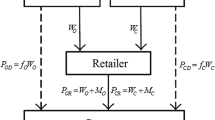Abstract
Small agricultural production enterprises have been under immense economic pressures for many years. It is our belief that a favorable impact can be made on small farm enterprises through the development and implementation of models that address their basic needs and open new markets and production initiatives. In this paper, we develop models for supply chain issues facing small farmers, solve them, and suggest their uses and future considerations. In particular, we consider B2C and B2B aspects of an agricultural supply chain model. The B2C aspect is considered in direct farmer to consumer sales in retail markets, while the B2B aspect is represented by transactions through agricultural cooperatives. We evaluate key strategic decisions such as whether to form cooperative agreements with other farmers and if so, how large to make the cooperative, and the production quantities at which farmers would like to sell directly to customers with or without using the cooperative.
Similar content being viewed by others
References
Boger, S., Hobbs, J. E., & Kerr, W. A. (2001). Supply chain relationships in the Polish pork sector. Supply Chain Management: An International Journal, 6(2), 74–82.
Buccola, S. T. (1994). Cooperatives. In: C. Arntzen & E. M. Ritter (Eds.), Encyclopedia of agricultural science (pp. 431–440). San Diego: Academic Press.
Cox, A., Chicksand, D., & Palmer, M. (2007). Stairways to heaven or treadmills to oblivion? Creating sustainable strategies in red meat supply chains. British Food Journal, 109(9), 689–720.
Fischer, M. L., Hammond, J. W., & Dahl, D. C. (1981). Impacts of farm supply cooperatives on oligopolistic farm input markets: a theoretical analysis. Staff Paper P81-16, Department of Agricultural and Applied Economics, University of Minnesota.
Gergiadis, P., Vlachos, D., & Iakovou, E. (2005). A system dynamics modeling framework for the strategic supply chain management of food chains. Journal of Food Engineering, 70, 351–364.
Gigler, J. K., Hendrix, E. M. T., Heesen, R. A., van den Hazelkamp, V. G. W., & Meerdink, G. (2002). On optimisation of agri chains by dynamic programming. European Journal of Operational Research, 139, 613–625.
Glen, J. J., & Tipper, R. (2001). A mathematical programming model for improvement planning in a semi-subsistence farm. Agricultural Systems, 70, 295–317.
Hobbs, J. E., & Young, L. M. (2000). Closer vertical co-ordination in agri-food supply chains: a conceptual framework and some preliminary evidence. Supply Chain Management: An International Journal, 5(3), 131–142.
Kinsey, J., & Senaur, B. (1996). Food marketing in an electronic age: implications for agricultural products. Working Paper 96-2, Department of Applied Economics, University of Minnesota.
Lawrence, J., & Duffy, M. (1999). Recent trends in industrialized agriculture. In: Agriculture in the 21st century – surviving and thriving (pp. 3–6). Iowa State University.
Lerman, Z., & Parliament, C. (1989). Industry and size effects in agricultural cooperatives. Staff Paper P89-40, Department of Agricultural and Applied Economics, University of Minnesota.
Loftsgard, L. D., & Heady, E. O. (1959). Application of dynamic programming models for optimum farm and home plans. Journal of Farm Economics, 41, 51–62.
Maia, L. O. A., Lago, R. A., & Qassim, R. Y. (1997). Selection of postharvest technology routes by mixed-integer linear programming. International Journal of Production Economics, 49, 85–90.
Marsden, T., Banks, J., & Bristow, G. (2000). Food supply chain approaches: exploring their role in rural development. Sociologia Ruralis, 40(4), 424–438.
Matopoulos, A., Vlachopoulou, M., Manthou, V., & Manos, B. (2007). A conceptual framework for supply chain collaboration: empirical evidence from the agri-food industry. Supply Chain Management, 12(3), 177–186.
Memishi, R. (2001). Agribusiness is pioneering new modes of B2B e-commerce. Internet World, May 15.
Mowat, A., & Collins, R. (2000). Consumer behaviour and fruit quality: supply chain management in an emerging industry. Supply Chain Management: An International Journal, 5(1), 45–54.
Petraglia, L. M., & Rogers, R. T. (1991). The impact of agricultural marketing cooperatives on market performance in U.S. Food Manufacturing Industries for 1982. Amherst: University of Massachusetts.
Poot, E. H. , & Hendrix, E. M. T. (1996). A chain model for potted plants. In: L. Fortuin, P. van Beek, & L. van Wassenhove (Eds.), OR at work (pp. 235–249). London: Taylor & Francis.
Sells, J. E., & Audsley, E. (1991). The profitability of an Arable wood crop for electricity. Journal of Agricultural Engineering Research, 48, 273–285.
Sexton, R. J. (1986). The formation of cooperatives: a game theoretic approach with implications for cooperative finance, decision making, and stability. American Journal of Agricultural Economics, 68, 214–225.
Sporleder, T. L., & Goldsmith, P. D. (1997). The risk mitigation aspects of agricultural cooperatives. In: M. Cook, R. Torgerson, T. Sporleder, & D. Padberg (Eds.), Cooperatives: their importance in the future food and agriculture system (pp. 69–82). National Council of Farmer Cooperatives.
USDA/RB-CS (U.S. Department of agriculture/Rural Business-Cooperative Service) (1998). Cooperative historical statistics. Cooperative Information Report 1, Section 26.
van Bekkum, O. F., & van Dijk, G. (1997). Agricultural cooperatives in the European Union: trends and issues on the Eve of the 21st century. Assen: Van Gorkum.
van Der Meer, C. (2006). Exclusion of small-scale farmers from coordinated supply chains. In: R. Ruben, M. Slingerland, & H. Nijhoff (Eds.), Agro-food chains and networks for development (pp. 209–217). Netherlands: Springer.
Author information
Authors and Affiliations
Corresponding author
Rights and permissions
About this article
Cite this article
Jang, W., Klein, C.M. Supply chain models for small agricultural enterprises. Ann Oper Res 190, 359–374 (2011). https://doi.org/10.1007/s10479-009-0521-8
Published:
Issue Date:
DOI: https://doi.org/10.1007/s10479-009-0521-8




